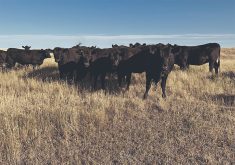CALGARY — A global study has shown that increasing periods of extreme short-term drought due to climate change will likely have a more severe impact than expected on grasslands relied on by beef producers.
“I think the message from this one is that we probably have been underestimating the effects of the droughts that we’re going to see in the future,” said Cameron Carlyle, a rangeland ecologist at the University of Alberta.
Related stories:
Read Also

Quebec pork company calls for transparency around gene-edited pigs
Quebec-based pork company duBreton is calling for transparency around meats from gene-edited pigs on concerns that a lack of mandatory labelling will confuse consumers, and dilute certification claims. The organic sector is also calling for labelling rules.
- Rivers face increased demand and dwindling water supply
- Rested pastures able to absorb more moisture
- B.C. ranchers want focus on water management
- Hub to study climate change’s effect on water
“And so, we probably should be thinking about preparing for those more extreme reductions in our grassland productivity.”
The study found that one year of severe short-term drought collectively caused a 40 percent loss in plant growth in grasslands and shrublands in North and South America as well as Africa, Asia, Australia and Europe, said Carlyle. Normal droughts collectively caused a 20 percent reduction, he said.
The average loss in plant growth at two sites in Alberta because of extreme drought was 10 percent, with droughts likely to generally increase in severity as they get closer to the equator, he added.
Grasslands and shrublands cover more than 40 percent of the world’s ice-free land surface. They often have low and variable rainfall, which makes them more vulnerable to climate change.
A university statement said drier sites with less diverse plant life, such as parts of southern Alberta, are likely to be the most vulnerable to extreme drought. It is vital to maintain plant diversity because a larger number of grass or flowering plant species increases the chances there will be more drought resistant plants, Carlyle said in the statement.
Although drought directly affects producers, everyone relies on grasslands in some way, he said during an interview.
“They’re important for storing and sequestering carbon, helping to offset climate change. They’re important for wildlife and biodiversity. Many of our endangered and threatened species rely on them, and so we want to think about how we can manage and protect our grasslands so that they continue to do those other things that we value for us in the future.”
Several years of dry conditions in much of Western Canada continued into this winter.
“And so, I think this is just more to the point of our study is that we need to understand what droughts are going to look like in the future.”
The study involved more than 170 researchers on every continent except Antarctica. It is the first to use a standardized global experiment to provide a worldwide overview about extreme short-term droughts, which are statistically defined as one-in-100-year events but are expected to become more frequent.
Scientists had earlier explored how droughts of a year or less duration can have critical impacts on the amount of forage available for cattle grazing on grassland.
“We’ve been looking at those questions for a while,” said Carlyle. “But when we looked at different studies done in different locations, there were a lot of inconsistencies in the results, and one of the possible explanations for those inconsistencies was that different methodology was being used across those different studies.”
The current study involved year-long droughts that were experimentally imposed over vegetation at 100 grassland and shrubland sites around the world to simulate extreme short-term droughts.
It included about 10 rainout shelters installed at the University of Alberta’s Mattheis Research Ranch north of Brooks, Alta., and the Roy Berg Kinsella Research Ranch southeast of Vegreville.
The 2.5 by 2.5 metre structures were each about double the size of a large dining table and about as high off the ground, said Carlyle. They had a slight slope and were roofed with clear acrylic slats that intercepted and diverted about half the natural precipitation received by each plot of land.
Mattheis contains native prairie grassland, and Roy Berg Kinsella has aspen parkland consisting of aspen trees interspersed with grassland. Both ranches have never been cultivated and tend to have lower levels of precipitation, said Carlyle.
He said the study targeted such sites because “we were taking half of the water away, but also because the natural rainfall was lower, and then we looked at whether or not we could categorize that as an extreme drought.”
Beef producers could mitigate some of the effects by grazing their herds in different ways, said Carlyle. They potentially include using adaptive multi-paddock grazing, which involves frequent rotation of high densities of cattle through fields using small paddocks.
Research has shown it promotes higher plant production and infiltration of water into soil, “so that means that if rain falls and lands on the ground, it’s more likely to go into the ground where plants can use it, and anecdotally, producers that practice those types of methods do tend to see some better resilience to drought than conventional practices.”


















